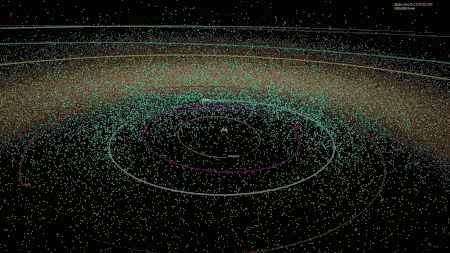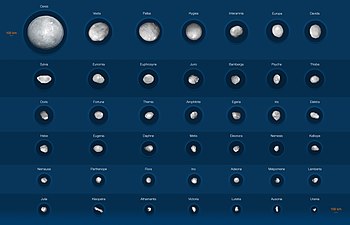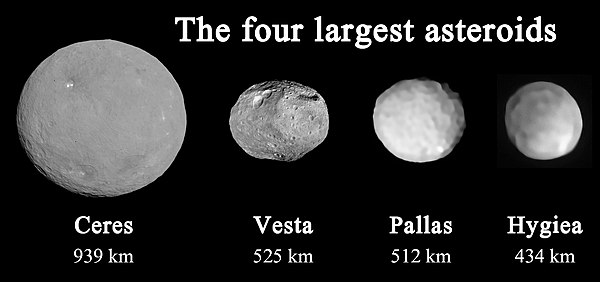Asteroid Belt

The ring of Asteroids whose orbit around the Sun is located between the orbits of Mars and Jupiter.
Astronomy
Evolutionary History (Origin)
The asteroid belt formed from the primordial solar nebula as a group of planetesimals. Planetesimals are the smaller precursors of the protoplanets. Between Mars and Jupiter, however, gravitational perturbations from Jupiter imbued the protoplanets with too much orbital energy for them to accrete into a planet. Collisions became too violent, and instead of fusing together, the planetesimals and most of the protoplanets shattered. As a result, 99.9% of the asteroid belt's original mass was lost in the first 100 million years of the Solar System's history. The asteroids have undergone considerable evolution since their formation, including internal heating (in the first few tens of millions of years), surface melting from impacts, space weathering from radiation, and bombardment by micrometeorites. The current asteroid belt is believed to contain only a small fraction of the mass of the primordial belt. Computer simulations suggest that the original asteroid belt may have contained mass equivalent to the Earth's. Primarily because of gravitational perturbations, most of the material was ejected from the belt within about 1 million years of formation, leaving behind less than 0.1% of the original mass.
When the asteroid belt was first formed, the temperatures at a distance of 2.7 AU from the Sun formed a "snow line" below the freezing point of water. Planetesimals formed beyond this radius were able to accumulate ice. In 2006, a population of comets had been discovered within the asteroid belt beyond the snow line, which may have provided a source of water for Earth's oceans. According to some models, outgassing of water during the Earth's formative period was insufficient to form the oceans, requiring an external source such as a cometary bombardment.
History of Observation
In 1596, Johannes Kepler wrote, "Between the orbits of Mars and Jupiter, I place a planet," in his Mysterium Cosmographicum, stating his prediction that a planet would be found there. While analyzing Tycho Brahe's data, Kepler thought that too large a gap existed between the orbits of Mars and Jupiter to fit his then-current model of where planetary orbits should be found.
Titius-Bode Law
In an anonymous footnote to his 1766 translation of Charles Bonnet's Contemplation de la Nature, the astronomer Johann Daniel Titius of Wittenberg noted an apparent pattern in the layout of the planets, now known as the Titius-Bode Law.
| Celestial Body | Bode's Rule | Expected Distance in AU | Factual Distance (AU) |
|---|---|---|---|
Mercury 
|
0,4 + 0,0 | 0,4 | 0,39 |
Venus 
|
0,4 + 0,3 | 0,7 | 0,72 |
Earth 
|
0,4 + 0,6 | 1,0 | 1,00 |
Mars 
|
0,4 + 1,2 | 1,6 | 1,52 |
| Asteroids | 0,4 + 2,4 | 2,8 | 2,1-3,5 |
| Ceres | 2,77 | ||
Jupiter 
|
0,4 + 4,8 | 5,2 | 5,2 |
Saturn 
|
0,4 + 9,6 | 10,0 | 9,54 |
Uranus 
|
0,4 + 19,2 | 19,6 | 19,8 |
Neptune 
|
0,4 + 38,4 | 38,8 | 30,1 |
Pluto 
|
0,4 + 76,8 | 77,2 | 39,5 |
On January 1, 1801, Giuseppe Piazzi, astronomer at the University of Palermo, Sicily, found a tiny moving object in an orbit with exactly the radius predicted by this pattern. He dubbed it "Ceres", after the Roman goddess of the harvest and patron of Sicily. Piazzi initially believed it to be a comet, but its lack of a Coma suggested it was a planet. By 1807, further investigation revealed three new objects in the region: Pallas, Juno and Vesta. In 1845, though, astronomers detected a fifth object (Astraea) and, shortly thereafter, new objects were found at an accelerating rate. Counting them among the planets became increasingly cumbersome. The discovery of Neptune in 1846 led to the discrediting of the Titius–Bode law in the eyes of scientists because its orbit was nowhere near the predicted position. To date, no scientific explanation for the law has been given, and astronomers' consensus regards it as a coincidence.
Structure and Composition
About 60% of the main belt mass is contained in the four largest asteroids: Ceres, Vesta, Pallas, and Hygiea. The total mass of the asteroid belt is calculated to be 3% that of the Moon.
Ceres, the only object in the asteroid belt large enough to be a dwarf planet, is about 950 km in diameter, whereas Vesta, Pallas, and Hygiea have mean diameters less than 600 km. The remaining bodies range down to the size of a dust particle. The asteroid material is so thinly distributed that numerous unmanned spacecraft have traversed it without incident. Nonetheless, collisions between large asteroids occur and can produce an asteroid family, whose members have similar orbital characteristics and compositions.
In January 2014, European Space Agency (ESA) scientists detected water vapor on Ceres. The finding was unexpected because Comets, not asteroids, are typically considered to "sprout jets and plumes". According to one of the scientists, "The lines are becoming more and more blurred between comets and asteroids".
The total number is estimated at around 75 000 and 100 000. Several thousand have already been catalogued. For a long time, it was thought that they were the remnants of a destroyed planet. However, the current theory is that they are the dispersed matter of a larger planet that never actually formed because the condensation of this matter into a larger whole was prevented by Jupiter's powerful gravitational force.
The first asteroids, which remain the most widely known, were discovered at the beginning of the 19th century in the asteroid belt: Ceres, Pallas, Juno and Vesta. Ceres, Pallas and Vesta are the three largest[2] bodies in the belt.
Asteroid Families
Approximately one-third of the asteroids in the asteroid belt are members of an asteroid family. These share similar orbital elements, such as semi-major axis, eccentricity, and orbital inclination as well as similar spectral features, all of which indicate a common origin in the breakup of a larger body.[3]
The largest asteroid to be a true member of a family is Vesta. The Vesta family is believed to have formed as the result of a crater-forming impact on Vesta.
Table of Asteroids
| Asteroid No. | Name | Diameter (Average) | Date of Discovery | Discovered by | Symbol |
|---|---|---|---|---|---|
| 1 | Ceres | 940 km | January 1, 1801 | Giuseppe Piazzi | 
|
| 2 | Pallas | 512±3 km | March 28, 1802 | Heinrich Olbers | 
|
| 3 | Juno | 267 km | September 1, 1804 | Karl Ludwig Harding | 
|
| 4 | Vesta | 516 km | March 29, 1807 | Heinrich Olbers | 
|
| 5 | Astraea | 117 km | December 8, 1845 | Karl Ludwig Hencke | |
| 6 | Hebe | 195 km | July 1, 1847 | Karl Hencke | |
| 7 | Iris | 209 km | August 13, 1847 | John Russel Hind | |
| 8 | Flora | 135 km | October 18, 1847 | John Hind | |
| 9 | Metis | 190 km | April 15, 1848 | Andrew Graham | |
| 10 | Hygiea | 409 km | April 12, 1849 | Annibale de Gasparis | |
| 11 | Parthenope | 162 km | May 11, 1850 | Annibale Gasparis | |
| 12 | Victoria | 113 km | September 13, 1850 | John Hind | |
| 13 | Egeria | 208 km | November 2, 1850 | Annibale Gasparis | |
| 14 | Irene | 182 km | May 19, 1851 | John Hind | |
| 15 | Eunomia | 272 km | July 29, 1851 | Annibale Gasparis | |
| 16 | Psyche | 250 km | April 17, 1852 | Annibale Gasparis | |
| 42 | Isis | 100 km | May 23, 1856 | N.R. Pogson | |
| 52 | Europa | 300 km | February 4, 1858 | Goldschmidt, H. | |
| 511 | Davida | 326 km | May 30, 1903 | Raymond Smith Dugan | |
| 704 | Interamnia | 317 km | October 2, 1910 | V. Cerulli | |
| 3045 | Alois | January 8, 1984 | Joe Wagner |
See also
Weblinks
- Wikipedia: Asteroid belt
- Wikipedia: Asteroids in fiction
- Wikipedia: Titius-Bode law
- How I Killed Pluto (Astronomer Mike Brown, 2010)
- Ceres, Pallas Vesta and Hygeia (GravitySimulator.com, 2007)
- NASA: Dawn-Mission
- list of known asteroids (Astrodienst)
- NASA: Near-Earth Object Program
- The Centaur Research Project (Robert von Heeren)
- Pictures of Vesta by Dawn (Spiegel, 2013; German)

Bibliography
- Demetra George, 1986, Asteroid Goddesses: The Mythology, Psychology and Astrology of the Reemerging Feminine, ACS Publications, Inc.
- Mike Brown: How I Killed Pluto and Why It Had It Coming, Spiegel & Grau; 2010, 288 pages, ISBN-10:0385531087, ISBN-13: 978-0385531085
Notes and References
- ↑ The animation depicts a mapping of the positions of known near-Earth objects (NEOs) at points in time over the past 20 years, and finishes with a map of all known asteroids as of January 2018. Asteroid search teams supported by NASA's NEO Observations Program have found over 95 percent of near-Earth asteroids currently known. There are now over 18,000 known NEOs and the discovery rate averages about 40 per week. Image credit: NASA/JPL-Caltech
- ↑ Though the number of asteroid density measurements has begun to increase rapidly in the last few years, still only a tiny fraction of the known asteroids have usable density measurements
- ↑ Some asteroid families have formed recently, in astronomical terms
- ↑ Most of them are larger than 100 kilometres, with the two biggest asteroids being Ceres and Vesta, which are around 940 and 520 kilometres in diameter, and the two smallest ones being Urania and Ausonia, each only about 90 kilometres. The images of the asteroids have been captured with the Spectro-Polarimetric High-contrast Exoplanet REsearch (SPHERE) instrument on ESO’s Very Large Telescope
